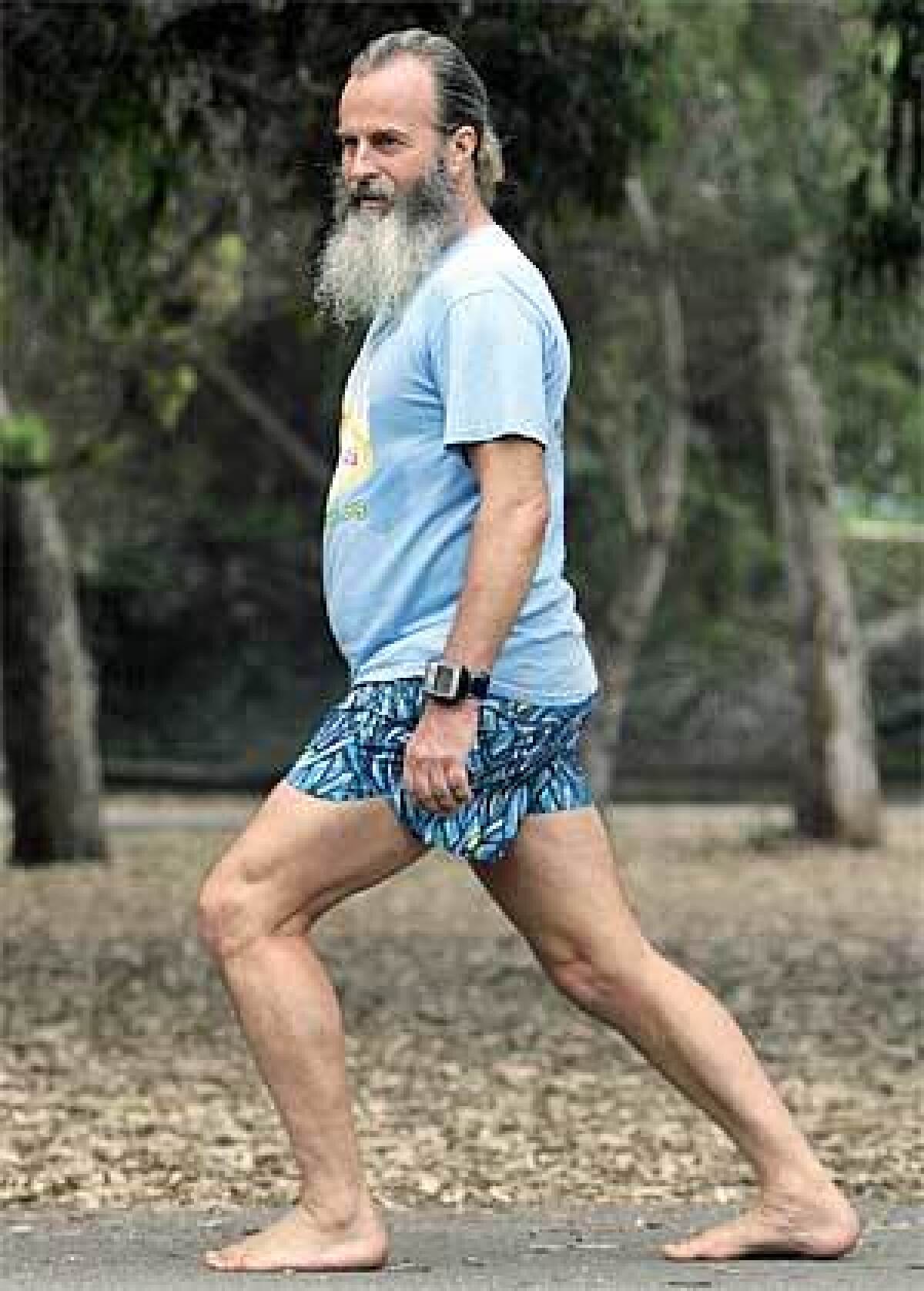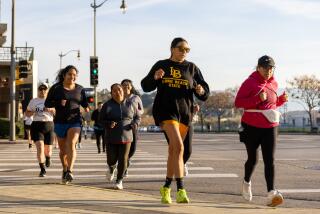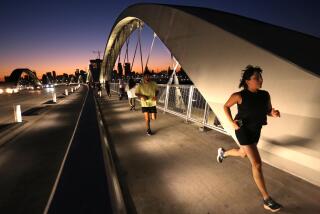Runners are baring their very soles

- Share via
“Ouch!” “Oooh!” “Oww!” “Omigod, that hurts!” Those grunts of pain and anguish weren’t coming from us -- a group of 10 people running barefoot on a concrete pathway at Central Park in Huntington Beach early one recent Saturday morning. They were being emitted by a grimacing group of shoe-wearing, dog-walking women who were staring at us as we passed.
But surprisingly, it didn’t hurt to run in bare feet. In fact, it felt great. Every step of our 30-minute barefoot run was pure pleasure -- far more natural and comfortable than a run in shoes.
My forefeet led the way, lightly and smoothly mapping the terrain instead of thunking to the ground heels-first. My air-cooled toes automatically spread wide instead of being smushed together. And my body, without even trying, seemed to instinctively run “softly” -- knees slightly bent, legs crouched, absorbing shock like a spring. My right knee, tender on runs since undergoing meniscus surgery a couple of months before, didn’t feel a thing.
On top of all that, I found myself wrapped in a childlike joy that was almost addictive.
“That’s a pretty common reaction,” says Ken Bob Saxton, 54, the affable, long-haired, thick-bearded organizer of this barefoot-running workshop and guru of a small but rapidly growing movement. “It’s like your feet are suddenly free -- like they are getting out of prison. And they are: your shoes.”
Barefoot Ken, as he is known (all accomplished barefooters routinely use “barefoot” before their names), hates shoes. He never wears them, even at his computer technician job at Cal State Long Beach. He says they desensitize the feet, encourage them to land heel first; and just generally cause blunt shock and imbalances that chafe skin and wreck knee and hip joints.
Because shoes insulate wearers from real biofeedback, he says, they limit the ability to listen to one’s body, leading to overuse injuries. He dumped his shoes after the 1987 Long Beach Marathon, his first 26.2-mile race. It left his feet so blistered that he quit marathons for a decade.
“I got tired of wearing out shoes, and shoes wearing out my feet,” he says. “I was desperate. Since I’d always enjoyed running barefoot on the beach, I finally tried it on the pavement.”
That experiment changed his life, ultimately establishing barefooting as a potential cure for some running injuries, implicating modern cushioned shoes in those injuries, and becoming the impetus for what may be the most counter-intuitive product in the history of sport: the barefoot running shoe.
Of course, Saxton isn’t the first person to run barefoot. Ethiopia’s Abebe Bikila won the 1960 Olympic marathon shoeless. South Africa’s Zola Budd was a barefoot sensation in the 1980s. Coaches from high school through Olympic level have used barefoot drills for decades to strengthen athletes’ feet. But Saxton took it to a new level.
Since 2002, he’s averaged 10 shoeless marathons a year, running fast enough to qualify for the Boston Marathon twice and earn profiles in a spate of publications including Runner’s World. More important, he started a website, Running Barefoot (runningbarefoot.org), that has become the leading information center on everything shoeless and a window of hope for injured runners desperate to keep it going.
Injury factor
Injuries decimate runners. Studies indicate that about half of all runners are injured every year. The London-based Sports Injury Bulletin puts it at 60% to 65%. The cause? “The heel strike,” says Santa Monica physical therapist Robert Forster, who provides videotaped running-form analysis at his training facility, Phase IV. “During running, you land with an impact of five times your body weight. When you land on your heel, the shock goes right into your joints. To lessen the shock, you have to land ‘softer’ -- and that means on your forefoot or midfoot with a bent leg, not on your heel with a straighter leg.”
A 2004 study by Dr. Timothy Noakes in the journal Medicine & Science in Sports & Exercise found that the forefoot landing inherent in barefooting (in which heel-striking is painful and unnatural) transmitted up to 50% less shock through the knees than heel-to-toe landings.
Six of the 10 people who showed up at Saxton’s barefoot running clinic were motivated by injury reduction.
Chris Yamasaki, 29, a real estate agent and one-year runner from Montebello who was suffering from shin splints, found out about Saxton’s website from a Runner’s World forum. “Now, I feel so good that I’m training to do a 10K barefoot,” he said two weeks after the clinic.
John Fretwell, a 47-year-old Mission Viejo administrator who had been having trouble with his left knee since he started running 18 months ago, said the pain was almost gone after eight 5-mile barefoot runs.
Mike Rose, 57, a retired naval officer from San Diego who has been running since 1986, says: “I think barefooting will help me last a few more decades.”
Three years ago, after he discovered the website of Missouri’s Barefoot Rick and then linked to Saxton’s larger site, Rose began barefooting in order to toughen his feet and cure his recurrent knee pain and soreness. He’s now a committed barefooter with two unshod 10Ks on his race resume.
He woke up at 5 a.m. to make it to the 7 a.m. clinic so he could pick up some tips for his upcoming first barefoot marathon, Huntington Beach’s Surf City, which was deliberately selected “because it’s Ken’s home turf.” Rose says the trip was worth it; he immediately picked up his speed, having learned to lift his toes on the landing, track his feet in a straighter line, and maintain a vertical arm swing.
Though barefooters initially run more slowly than they did in shoes -- the body has to accommodate to the new forefoot form and pay more attention to the ground to avoid rocks and other obstacles until the soles toughen up -- barefoot feet can be quite fleet.
“Barefooting does not compromise performance,” says Caltech doctoral student and clinic participant Julian Romero, a.k.a. Barefoot Julian, 26. “There’s less weight -- no shoes -- less friction, better heat management and automatically better form.” Proof: Among his 11 barefoot marathons was a second place finish at this year’s Duke City Marathon in Albuquerque in a time of 2 hours, 47 minutes.
And the winner? Romero’s 24-year-old brother, Barefoot Alex, also a Caltech doctoral student, who finished in 2:40 in his second barefoot marathon.
“I like being a role model for barefooting, but for the right reasons,” said Alex Romero, an evolutionary biologist. “Not to be a freak, but because it’s good for you. Humans evolved to run barefoot over millions of years. In 20 years, we have not adapted to these huge, cushioned running shoes that cause us to underuse our calves and all the muscles in our feet.” In 2005, after he got a stress fracture in his tibia while on the college track team, he read an article about Saxton and mentioned it to his brother.
Injury-free Julian -- needing a break from his dissertation research in microeconomic game theory -- started barefooting first, intellectually intrigued by its less-is-more benefits. After just three months of running unshod, an unusually rapid adaptation period for today’s artificially shortened calves and Achilles tendons, he completed the 2006 Las Vegas Marathon.
“One bad thing about barefooting in Vegas that day was all the attention; I didn’t like it,” says the now 7,000-mile barefooter. “But on the plus side, I met Barefoot Ken at the finish.”
‘Barefoot shoes’
All barefoot roads seem to lead through Saxton, regularly referred to as “the guru” or “the godfather.” But now even he is being eclipsed in barefooting circles, some say, by a force he helped nourish: Barefoot Ted McDonald -- the hilarious, stream-of-consciousness ultra-running barefooter profiled in Christopher McDougall’s 2009 bestseller “Born to Run.”
“I get thousands of e-mails from around the world now,” says McDonald, 45, who couldn’t run for longer than an hour without pain until he visited Saxton’s site six years ago and began barefooting. Last fall, banking on his growing fame and a tsunami of publicity from “Born to Run,” McDonald left his family’s Pasadena carousel business for Seattle, where he is now a full-time coach and motivational speaker.
“Ken and I are buddies, but he’s too dogmatic,” relative newcomer McDonald says. “He’s why barefooting for too long appeared to be eccentric and not more mainstream. He says your foot is enough. But it’s not.”
McDonald is referring to the Vibram FiveFingers, the individual-toed “barefoot shoes” that he wears almost every time he runs. The non-padded, virtual second skin of 2-millimeter rubber is made by the renowned Milan, Italy-based maker of rubber hiking boot soles and has become a sold-out sensation among barefoot and shod runners. They were introduced by Vibram in 2006 as water shoes for kayaking and sailing, but became a hit with runners seeking the benefits of barefooting with protection from rocks, glass and twigs.
Running stores are scrambling to get FiveFingers, which come in various models, including a trail shoe, but Vibram is so swamped that it is supplying only a few L.A. area stores.
“FiveFingers started taking off last summer, and went through the roof in June, after the word about them got out and ‘Born to Run’ gave them validity,” says Thac Lecong, the footwear buyer at FrontRunners. The Brentwood running store was the first in the region to carry FiveFingers.
“At the end of 2007, when Vibram tried to convince me that barefooting strengthened feet and muscles, I knew it made physiological sense. But they were so strange-looking,” Lecong says. “Now, I look like a genius for taking a chance on the order. Everyone wants them -- runners, water people, gym-goers, yoga. Some even want them just because they’re cool. But I’ve been in the business 17 years; this is not just a fad. There is a broad-based interest in the benefits it conveys.”
The mad-scramble success of the FiveFingers -- Vibram has a patent on the individual-toe design -- has unleashed a gusher of minimalist shoes. Finland’s limited-distribution FeelMax is rushing out new models. Nike is reportedly expanding on its minimalist Free line.
The buzz on Skora, a shoe set to debut in spring, is so hot that owner David Sypniewski, a Canadian who moved to Florida to launch the brand after he “discovered the joy of running through Ken’s site,” already has been interviewed by numerous running magazines.
This rush to “barefoot shoes” rolls the eyes of Saxton, who a decade ago, as the newsletter editor of the Snail’s Pace Running Club in Orange County, irritated people by continually writing about barefooting.
“Anything you put between your feet and the ground desensitizes and weakens your feet,” he says. “And if you don’t learn how to run barefoot correctly to start with, you’ll eventually have problems with Vibrams.”
Which is why he did not allow them at the Saturday workshop.






